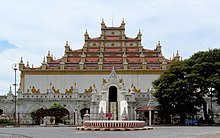| Atumashi Monastery | |
|---|---|
မဟာ အတုလဝေယန် ကျောင်းတော်ကြီး | |
 | |
| Religion | |
| Affiliation | Theravada Buddhism |
| Location | |
| Country | Mandalay, Mandalay Region, Burma |
| Geographic coordinates | 22°0′3″N 96°6′45″E / 22.00083°N 96.11250°E |
| Architecture | |
| Founder | King Mindon Min |
| Completed | 1857 (167 years ago) Reconstructed 1996 |
The Atumashi Monastery (Burmese: အတုမရှိကျောင်း [ʔətṵməʃḭ tɕáʊɰ̃]; formally Mahā Atulaveyan Kyaungdawgyi or မဟာ အတုလဝေယန် ကျောင်းတော်ကြီး [məhà ʔətṵla̰ wèjàɰ̃ tɕáʊɰ̃dɔ̀dʑí]) is a Buddhist monastery located in Mandalay, Myanmar (Burma).[1]
History
[edit]
It was built in 1857 by King Mindon, two years after the capital was moved to Mandalay.[1] The monastery was built at a cost of 500,000 rupees.[2] The original monastery structure was built using teak, covered with stucco on the outside, with its peculiar feature being that it was surmounted by five graduated rectangular terraces instead of the traditional pyatthats, Burmese-style tiered and spired roofs.[2]
The structure burned down in 1890 after a fire in the city destroyed both the monastery and the 30 feet (9.1 m) tall Buddha image, as well as complete sets of the Tipitaka.[1] During the fire, a 19.2-carat (32 ratti) diamond, which adorned the Buddha image (originally given to King Bodawphaya by Maha Nawrahta, the Governor of Arakan) disappeared as well.[2]
In 1996, Burma's Archaeological Department reconstructed the monastery with prison labor.[1]
Images
[edit]-
Golden door
-
Interior
Notes
[edit]- ^ a b c d Fiala 2002.
- ^ a b c List of Ancient Monuments in Burma 1910.
References
[edit]- List of Ancient Monuments in Burma (I. Mandalay Division). Vol. 1. Rangoon: Office of the Superintendent, Govt. Printing, Burma. 1910.
- Fiala, Robert D. (2002). "Atumashi Kyaung Temple, Mandalay, Myanmar". Asian Historical Architecture. Retrieved 11 November 2013.



Well, that’s interesting to know that Psilotum nudum are known as whisk ferns. Psilotum nudum is the commoner species of the two. While the P. flaccidum is a rare species and is found in the tropical islands. Both the species are usually epiphytic in habit and grow upon tree ferns. These species may also be terrestrial and grow in humus or in the crevices of the rocks.
View the detailed Guide of Psilotum nudum: Detailed Study Of Psilotum Nudum (Whisk Fern), Classification, Anatomy, Reproduction